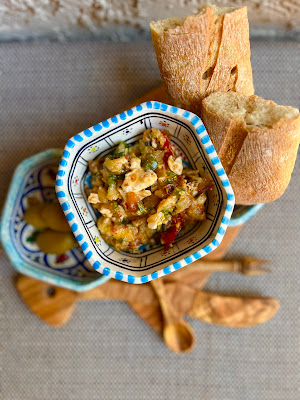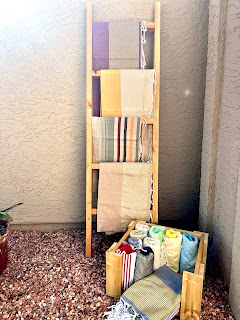Keftaji - Recipe & Story
Keftaji
Use equal amounts:
potato
acorn squash
zucchini
tomato
eggplant
3 spicy peppers (increase or decrease depending on how spicy you like it)
5 cloves of garlic
2 eggs
salt & pepper
harissa
olives
parsley
oil (for frying)
olive oil
1. Put 2 cups of frying oil in a pot and put over medium high. While the oil heats up, slice all the veggies 1/4 inch thick.
2. Fry all the veggies in batches, removing the finished veggies to a casserole dish. (I like to leave the tomatoes until the end because they leave little floaters in the oil that can burn.)
3. Carefully transfer about 1/4 cup of oil to a small fry pan and fry the garlic and eggs, leaving the yolks runny.
4. Season with salt & pepper. (I hate that phrase, because how am I supposed to know how salty or peppery it should be? I usually use about a teaspoon of each.)
5. Cut/mash veggies until they get to be the consistency of chunky mashed potatoes. (This is the part where there's a bit of technique, hold one knife in each hand and slice across, sort of like giant scissors.)
6. Stir in harissa and olive oil then garnish with olives & chopped parsley.
7 . Serve hot or cold with crusty bread for scooping.
NOTE: You can also add in fried mergues (sausages), kidney or liver.
—————
Diving into Tunisian cuisine is like taking a flavorful journey! And let me tell you about one gem in my cooking repertoire: keftaji (kef-tej-ee). Imagine a mix of colorful veggies, perfectly fried and teasing your senses with their delicious aroma. It's more than just a meal; it's a piece of culinary heritage.
You'll spot keftaji on the menus of cozy local joints, each putting their own spin on this Tunisian classic. Whether stuffed in a hearty sandwich with tuna and olives or served up on a "Tunisian plate" with a crispy baguette and a sunny-side-up egg, keftaji promises a taste explosion.
But for me, it's more than just food. It's a symbol of family ties and treasured customs. In my husband's family, keftaji takes the spotlight during Ramadan. Its smell signals the start of the evening feast, breaking the day's fast, and it's there again before sunrise, fueling up for the day ahead.
As the official keftaji chef in the family, I take pride in making it with care, ensuring every bite echoes Tunisian tradition. And let me share a secret: making keftaji can turn into a captivating ritual. Who hasn't zoned out while chopping tomatoes or frying eggplant? It's like a culinary trance, where every slice and sizzle feels meditative. Next thing you know, you're binge-watching "The Walking Dead" with a pan full of veggies!
In this humble dish lies not just food, but a taste of home, tradition, and the ties that bind us together.
Here, our delightful keftaji, is beautifully presented in vibrant Tunisian ceramic bowls atop our rustic olive wood cheese boards. Accompanied by the perfect utensils: an olive pick, a dainty coffee spoon, and a handy spreader. It's a feast for both the eyes and the palate!



Comments
Post a Comment